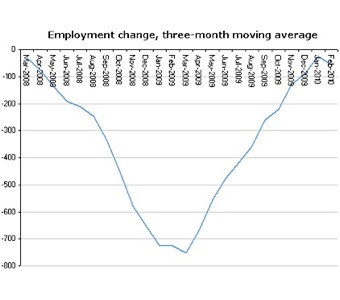
When the Bureau of Labor Statistics announced last Friday that the economy lost only 36,000 jobs in February, the usual choristers took that as good news. Christina Romer, the Chairwoman of the White House Council of Economic Advisers said, “Today’s report on the employment situation is consistent with the pattern of stabilization and gradual labor market healing we have been seeing in recent months.”
John Ryding and Conrad DeQuadros of RDQ Economics agreed: “This is a fairly strong employment report. There is plenty of evidence that the storms had a major impact on the labor market and, therefore, that this…decline in jobs actually masks a significant increase in employment.” And Paul Ashworth of Capital Economics said, “Employment is now very close to stabilizing.”
The BLS report, however, indicated that the unemployment rate stayed at 9.7 percent, and that the three snow storms (February 5 and 6, February 9 and 10, and February 24, 25, and 25) may have skewed the data.
In fact, just prior to release of the data on Friday, Larry Summers, chairman of the White House National Economic Council, pre-framed the report by asking “Who knows what the next number is going to be? The blizzards that affected much of the country during the last month are likely to distort the statistics … in past blizzards, those statistics are been distorted by 100,000 to 200,000 jobs.” Summers concluded that “It’s going to be very important…to look past whatever [the BLS reports today] to gauge the underlying trend.”
One is reminded of Mark Twain, who wrote in North American Review:
Figures often beguile me, particularly when I have the arranging of them myself; in which case the remark attributed to Disraeli would often apply with justice and force: “There are three kinds of lies: lies, damned lies, and statistics.”
At least three questions are raised by the BLS report: 1. If 36,000 jobs were lost, why didn’t the unemployment rate go up? 2. How real is that employment rate, anyway? 3. What was the true impact of the storms on those numbers?
According to the National Inflation Association. “We saw a payroll decline in February of 36,000 jobs. If you discount the hiring of 15,000 temporary census works, 51,000 jobs were lost. The official unemployment rate stayed the same at 9.7 per cent, but including “discouraged workers” the unemployment rate [actually] increased from 16.5 per cent to 16.8 per cent.” Conrad DeQuadros, quoted earlier, said, “It’s hard to believe that the unemployment rate is falling when we’re not creating jobs yet.”
Barron’s writer G. Epstein said that “One way to get a certain kind of reader angry is to keep citing the official unemployment rate at 9.7 per cent and to mention only occasionally the broader measure of joblessness [which increased to] 16.8 per cent last month.” After comparing the “official” rate to the “unofficial” rate, he said, “I believe the disconcerting rise…to 16.8 percent is a meaningful indicator.” But even the official “9.7 per cent reading is bad enough.”
The chart, below, from the U.S. Bureau of Labor Statistics (BLS) is worth noting, especially the turndown in January and its continuation into February. As the New York Times noted in its Economix Blog, “It’s … possible that economists vastly overestimated the snow effect. It’s even possible the snow effect was close to zero.” If that is the case, then “the job market is no longer improving…and the recovery is losing steam.”

Regardless of the effect of the snow storms on the BLS report, it is clear that the promised growth of millions of jobs as a result of the stimulus plans throwing billions of dollars into the economy is missing. “What we see in this report is essentially a job market on pause,” according to Heidi Shierholz with the Economic Policy Institute. “The pace of decline has slowed dramatically, but jobs are not being created to put this country’s nearly 15 million unemployed back to work.” This sentiment was echoed by Paul Ashworth who said, “Eight months after the recession in output ended, that is hardly cause for celebration.”
House Republican leader John Boehner (R-Ohio), who has a Freedom Index rating of 94 percent, put the report into political context: “Mother Nature is a force to be reckoned with, but it’s the blizzard of higher taxes, wasteful spending and reckless borrowing coming out of Washington that’s destroying jobs in this country.” Putting this report in a larger perspective, a remarkably candid admission came from former Federal Reserve Governor Robert Heller: “A double dip recession is still very much in the cards. The big elephant in the room that nobody talks about is the huge federal deficit, and that will eventually force up interest rates [which] will kill both the business and consumer recovery.”
Perhaps the April report from the BLS will clarify things, provided it doesn’t snow in Washington in the meantime.
Photo of Oregon Worksource Employment office: AP Images



